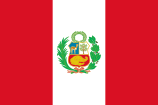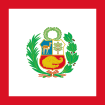This article needs additional citations for verification. (September 2013) |
 | |
| |
| Use | Civil flag and ensign |
|---|---|
| Proportion | 2:3 |
| Adopted |
|
| Design | A vertical triband of red (hoist-side and fly-side) and white. |
| Designed by | José de San Martín José Bernardo de Tagle Simón Bolívar |
| Pabellón nacional ('National Pavilion') | |
 | |
| Use | State flag, state and naval ensign |
| Proportion | 2:3 |
| Adopted | 31 March 1950 |
| Design | A vertical triband of red (hoist-side and fly-side) and white with the National Coat of Arms centered on the white band. |
| Bara de proa (Naval jack of Peru) | |
 | |
| Proportion | 1:1 |
| Design | A red square with the white square in the center bearing the Coat of Arms (Escudo de Armas) in the center. |
The Flag of Peru (Spanish: Bandera del Perú), often referred to as The Bicolour (la Bicolor), was adopted by the government of Peru in 1825, and modified in 1950. According to the article 49 of the Constitution of Peru, it is a vertical triband with red outer bands and a single white middle band.[1] Depending on its use, it may be defaced with different emblems, and has different names. Flag day in Peru is celebrated on 7 June, the anniversary of the Battle of Arica.